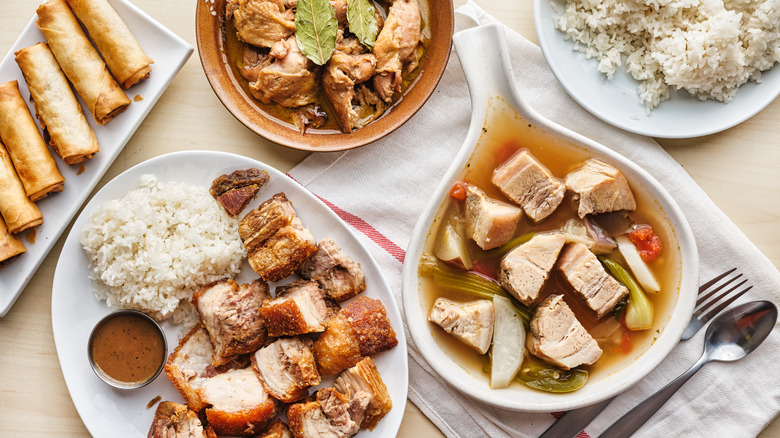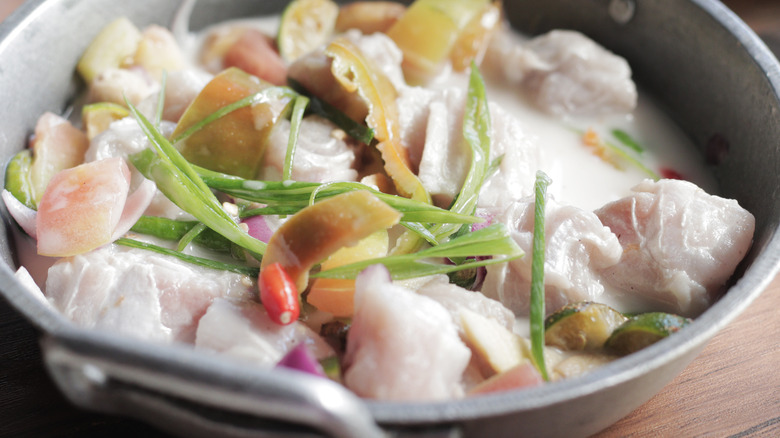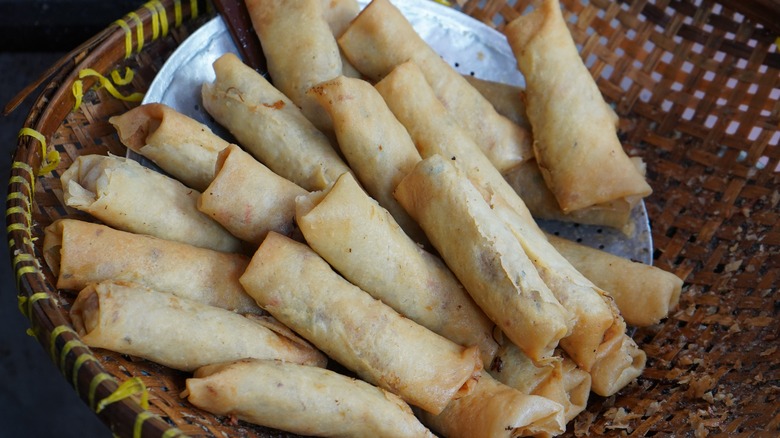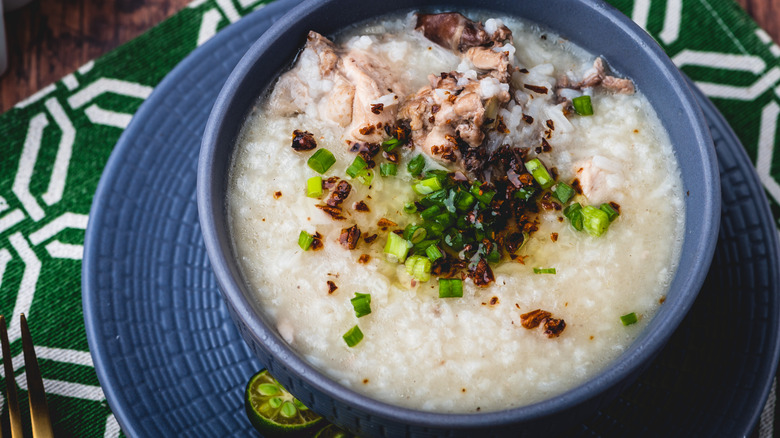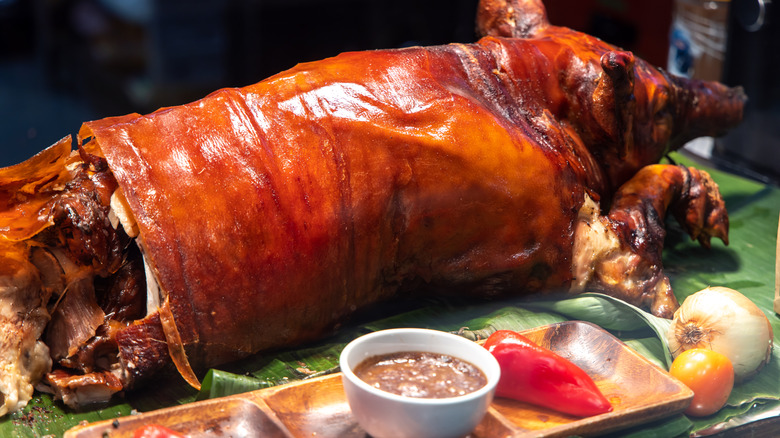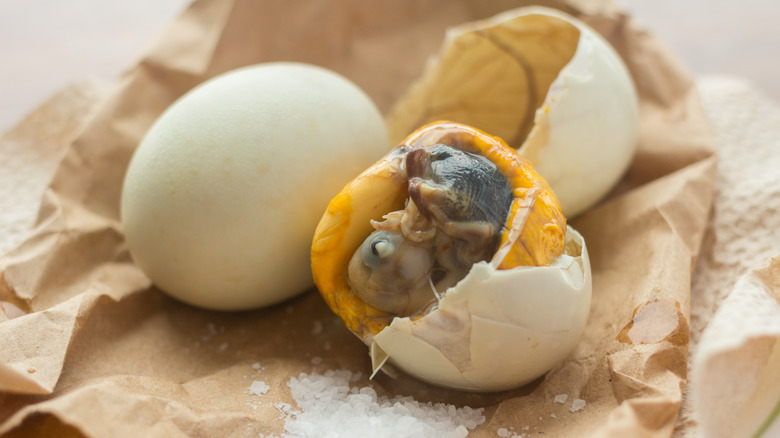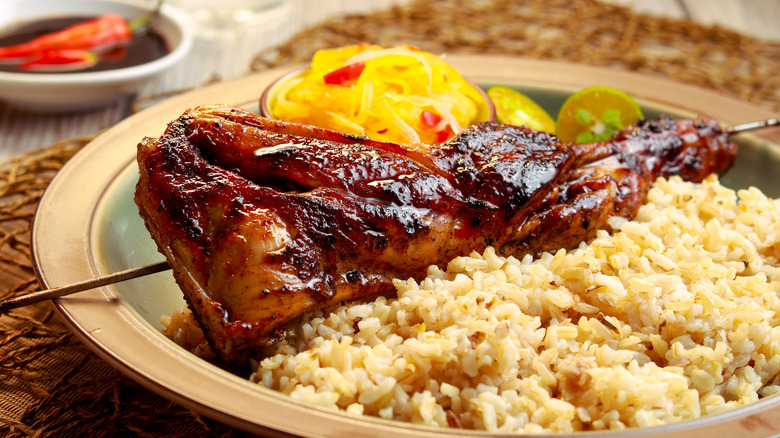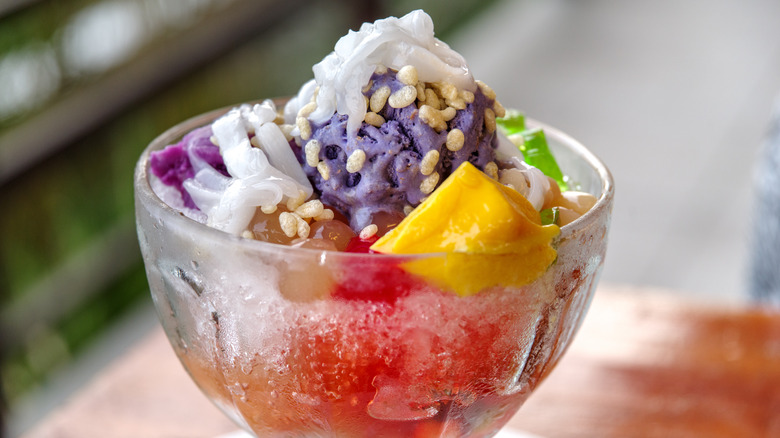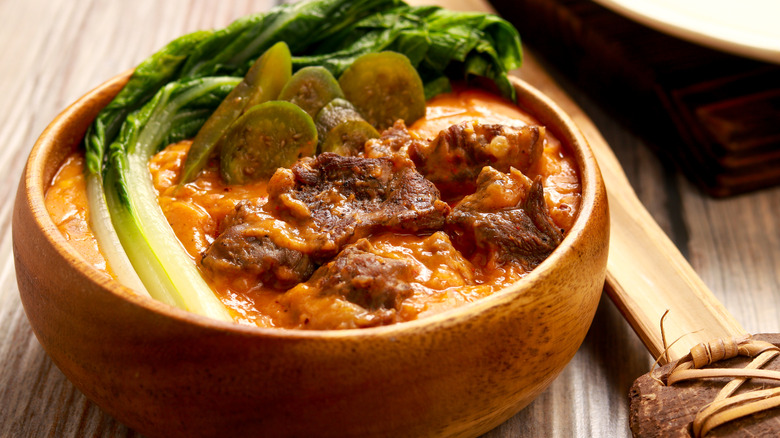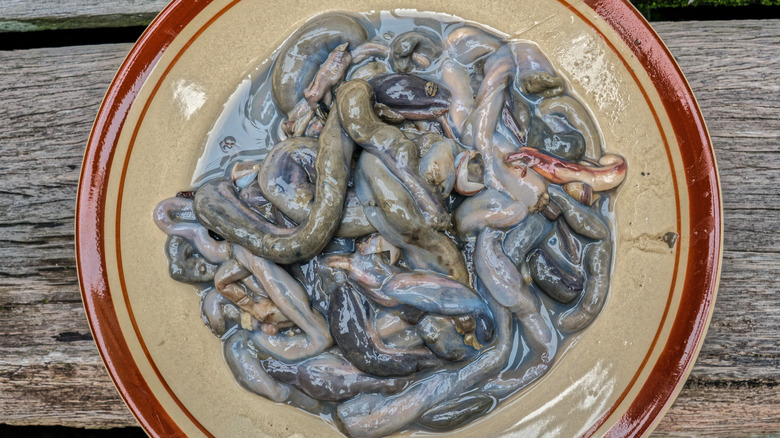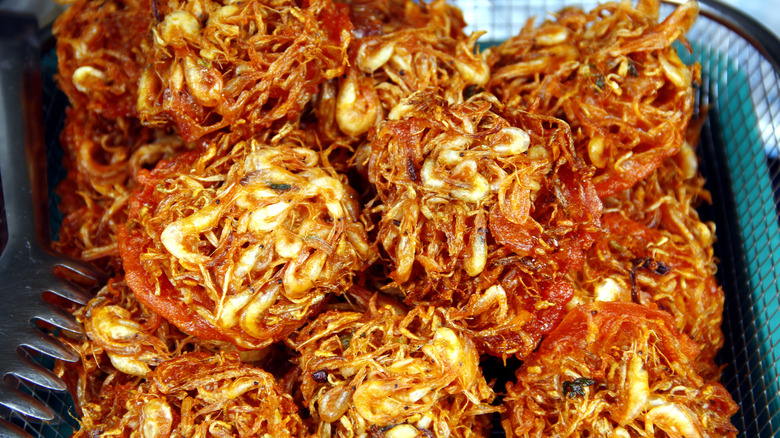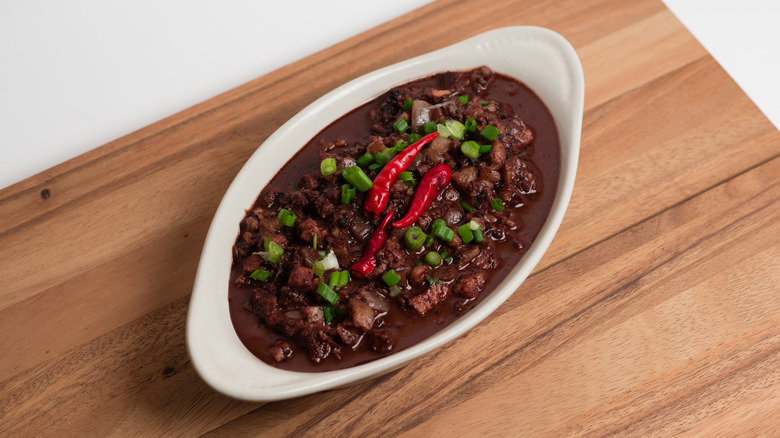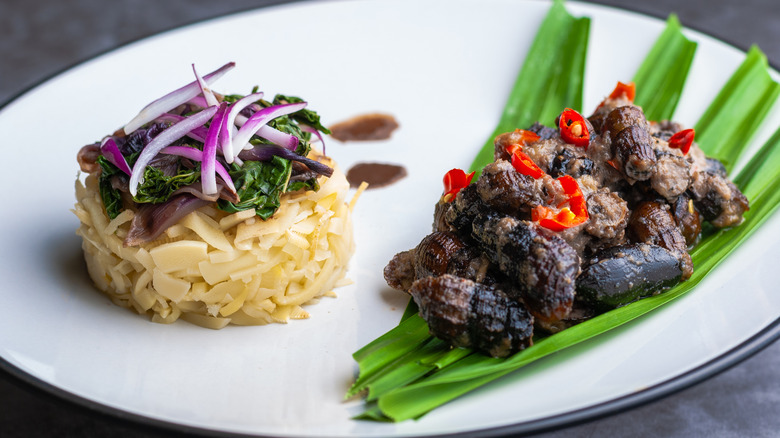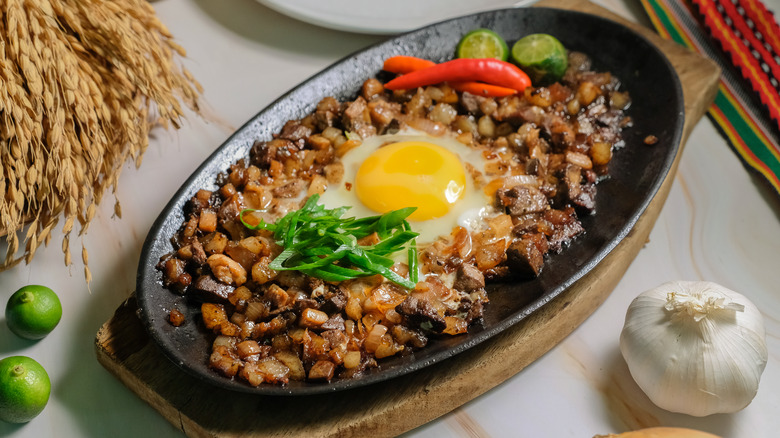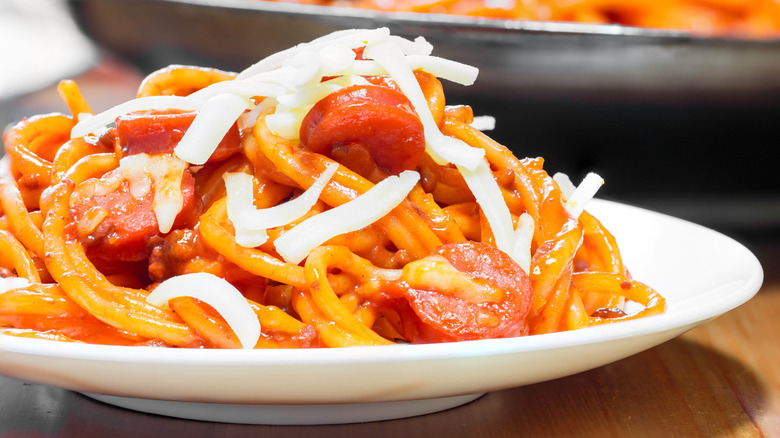The Best Filipino Foods You Probably Haven't Tried Yet
While Filipino cuisine may not be as well known internationally as Thai, Vietnamese, or Japanese food, it's just as rich and diverse as the culinary creations of its neighbors. In fact, we would venture to say that the culinary traditions of the archipelago of over 7,000 islands are hugely underrated. Shaped by colonialism and immigration, Filipino dishes range from the simple — think salted fish and rice — to elaborate feasts such as whole roasted pig (via Serious Eats). And the country's dishes are so varied, that some writers have even described Filipino cuisine as "Asian fusion before Asian fusion even existed" (via Best Pinoy Foodies).
While vegan and vegetarian food options aren't exactly plentiful in traditional Filipino cuisine, carnivores and seafood-lovers will be more than satisfied with what's on offer. Characterized by combinations of distinct flavors, Filipino food is bold and often hearty with ingredients such as vinegar, calamansi (Philippine lemon), and tamarind at the forefront of many of its dishes. Eager to find out more about this fascinating culinary landscape? We're here to fill you in on the best Filipino foods, so here we go!
Kinilaw
Also sometimes referred to as Filipino ceviche, kinilaw consists of cubed fish or meat. Unlike ceviche, however, kinilaw is marinated or "cooked" in coconut or cane vinegar rather than citrus juices (via Serious Eats). The tangy dish is also commonly composed of aromatics such as chili, ginger, and onion to bring out the flavors of the fresh seafood or meat. Other ingredients that also often make an appearance in kinilaw are sliced starfruit, green mango, and key limes (via Kitchn). The dish is typically served as an appetizer or pulutan (beer snacks), according to Foxy Folksy.
While Filipinos have been enjoying kinilaw for thousands of years, the dish differs slightly from region to region. Along the coast of the Philippines, kinilaw typically comes with seafood such as shrimp, clams, scallops, sea urchins, and fish including tambakol (yellowfin tuna) and tanigue (Spanish mackerel). Meanwhile, in the landlocked regions of the country without access to fresh seafood kinilaw is usually served with beef, pork, deer, or wild boar.
Lumpia
Said to have made its way to the Philippines with Chinese traders in the ninth century, lumpia is a staple of Filipino cuisine. In fact, some version of the dish is served at most gatherings as a side or snack. Filled with minced meat and vegetables, the rolls come in two main variations: fresh (think summer rolls) and deep-fried (think spring rolls) (via Epicurious). Some of the most common ingredients in lumpia include minced pork, chicken or prawns, and veggies such as carrots, bamboo shoots, and sprouts. The dish also comes in a sweeter banana version. Lumpia is commonly served with a sweet and sour sauce or peanut sauce (via Connect2Local).
One of the defining characteristics of lumpia rolls is their egg-batter wrap. These can be purchased ready-made at some Asian markets. Select thin, round wrappers for fresh lumpia or opt for the thicker, square wrappers for the deep-fried version. Alternatively, you can try your hand at making them yourself. And if your version of lumpia doesn't look exactly like that in pictures, take heart. Amelia Rampe, a food stylist and recipe developer with Filipino roots, writes, "The magic of lumpia is that every hand makes it differently. My mom and grandma make totally different styles of lumpia. My mom's were long, thin, and crisp and my grandma's were shorter, fatter, and never quite as crisp as mom's" (via Food52).
Arroz caldo
Often eaten for breakfast or as comfort food, arroz caldo is a thick rice porridge that's both flavorful and easy to make. Translating to rice stew in Spanish, arroz caldo combines parts of both Spanish and Chinese culinary traditions (via Little Epicurean). Similar to a Chinese congee, it's likely that the dish had been adapted to suit the palettes of the Spanish community living in the Philippines during colonial times. Today, arroz caldo is commonly served at street-side stalls (via Taste Atlas).
While rice porridge appears in the cuisines of many Asian countries, what makes arroz caldo unique is the addition of chicken. Depending on the region of the country, pork, tofu, and beef cuts are also sometimes added to the porridge (via Hapless Historian). The dish is usually cooked in a tasty broth made with garlic, ginger, and onion. For extra flavor, arroz caldo is sometimes topped with a hard-boiled egg and chicharrón or fried pork rinds.
Lechon
From weddings to birthdays, lechon or suckling pig is often the centerpiece of gatherings in the Philippines. Some have even gone as far as saying that lechon is the country's national dish (via Foodicles). Traditionally roasted on a bamboo spit over an open fire, the pig is usually stuffed with tamarind, lemongrass, chives, garlic, and onions (the specifics depend on the region). Once the meat is tender and juicy and the skin caramelized and crispy, lechon is served whole on a platter, with every part of the pig fair game for the taking (via Taste Atlas).
While the word lechon comes from the Spanish word for milk, "leche," it's more than likely that pigs were already roasted in the Philippines long before the arrival of the Spaniards in the country. According to Foodicles, the word given to the dish by Spaniards references milk-fed roasted suckling piglets. Interestingly, roasted pork in countries such as Cuba, Puerto Rico, the Dominican Republic, and Colombia is called "lechon," "lechon asado," and "lechona."
Balut
Not for the faint-hearted, balut is one of those dishes that whet curiosity but not necessarily the appetite. And while the dish — or rather snack — is essentially just a boiled duck egg, there's much more to the story. Typically served warm, balut is an egg that has been fertilized and incubated for two or three weeks. Depending on the stage of development, when eaten, the duck embryo can already have discernible features, such as eyes, beak, and feathers (via Culture Trip).
Often served on sidewalks or at wet markets in the Philippines, balut is believed to have been brought to the country by Chinese traders in the late 18th century. The Filipinos were quick to adopt the snack as their own, believing that it had aphrodisiac properties and promoted safe pregnancy (via Southeast Asia Backpacker).
Eating balut involves very specific etiquette. If you want to deal with balut like a local, place the egg on a table with the rounded end up. Gently tap the shell until it cracks and slowly peel it to make a small opening. Season the egg with vinegar, chili, or salt before drinking the juices from the shell. Once you've drunk the liquid inside the egg, pull it apart to expose the meat, yolk, and white — all are edible. Depending on its stage of development, the chick may have a slightly crunchy texture.
Chicken inasal
Considered a specialty of the city of Bacolod in Western Visayas, chicken inasal (grilled chicken) is popular across the Philippines (via Foxy Folksy). The tasty dish is made from chicken marinated in local ingredients such as pepper, garlic, lemongrass, calamansi, and achuete (annatto seed) oil. And there's no wastage here. From the paa (drumsticks) and pecho (breast) to baticulon (gizzard) and atay (liver), every part of the chicken receives the very same treatment (via World Food Guide).
Once marinated overnight, the chicken pieces are skewered and grilled over hot coals. And while grilling the chicken may seem easy, according to Panlasang Pinoy, there is a trick to getting things just right since the skin tends to burn before the meat is fully cooked inside. For chicken pieces that are juicy on the inside and crispy on the outside, the meat needs to be flipped every few minutes to prevent the chicken from burning. Chicken inasal is usually served with rice and a dipping sauce made from white vinegar and soy.
Halo-halo
Perfect for sweltering summer days, ice-cold halo-halo is a popular Filipino treat. Translating to "mix-mix" in Tagalog, halo-halo consists of shaved ice muddled with a variety of ingredients such as monggo beans, condensed milk, sago, and caramel custard (via Culture Trip). The classic dessert also frequently comes with an assortment of local fruit such as jackfruit and banana, and sometimes even features cheese, chili, and cornflakes (via Atlas Obscura).
Halo-halo has a fascinating history that harks back to the diverse cultures that make up Filipino cuisine. In fact, the dish has been influenced by numerous culinary traditions including those of Japan and America. In terms of its origins, halo-halo is most likely a variation of the Japanese dessert called kakigori, which features shaved ice served with sweet beans. Halo-halo became popular across the Philippines after Americans built the country's first ice plant in Manila in 1902 (via Ese Ne Tekrema).
Kare-kare
Traditionally cooked and served in a clay pot called palayok, kare-kare is a rich stew made with vegetables and meat such as oxtail, pork leg, chicken, goat, or tripe. What sets the dish off, however, is the addition of savory peanut gravy and annatto seeds. And while the dish is typically served without seasoning and spices, over the years some cooks have started topping it off with chili or green papaya (via Taste Atlas).
While kare-kare's exact origins are unclear, the dish may have been invented by the Moro people who were the indigenous inhabitants of the Philippines. According to another story, however, it was Indian soldiers who invented the dish after arriving in the Philippines on British ships. Not satisfied with the local cuisine, they accidentally invented kare-kare when trying to recreate Indian curry with local ingredients (via Serious Eats). Whatever the truth, today kare-kare is beloved in the Philippines where it is usually served during festivities such as birthdays and weddings (via Amusing Maria).
Tamilok
Also called woodworm, tamilok are saltwater clams that bore themselves into wood — hence the nickname. More specifically, the Filipino delicacy can be found in underwater logs and tree trunks (via Atlas Obscura). As such, tamilok are usually found in mangrove areas. And since harvesting the clams is now done for commercial purposes, some have expressed concern that overharvesting — especially in tourist areas where tamilok are sold as an "exotic food" — might disturb the delicate mangrove ecosystem in the country (via Fondazione Slow Food).
Around a foot long, the mollusks are commonly eaten raw ceviche-style after they are cured with vinegar — a practice known locally as kinilaw. Tamilok are typically sold by street food vendors in cups with wasabi and other dipping sauces. They can also be found in some restaurants. And just like oysters, tamilok aren't meant to be chewed but swallowed whole. So what about the taste? According to the Travel Food Atlas, tamilok have been described as "very fishy with a slimy, creamy, milky texture."
Okoy
Also spelled ukoy, okoy are a type of crispy shrimp fritter. The deep-fried appetizer is often made with unpeeled or dried shrimp to enhance the dish's crispiness and various vegetables such as sweet potatoes, squash, mung bean sprouts, carrots, and green papaya. In some cases, the shrimp is replaced with calamari or small fish such as anchovies or other dulong (small marine or freshwater fish). Before being deep-fried, both the seafood and vegetables are mixed with pancake-like batter, which is made from standard flour, rice flour, or a mixture of cornstarch and eggs (via 196 Flavors).
Believed to have originated in Laguna, a province southwest of Manila city, golden-brown okoy are commonly sold by street vendors as an afternoon snack. The fritters have also recently started appearing on restaurant menus as a side dish. Okoy are typically served with a sweet and sour sauce or a spicy vinegar dip (via Recipes by Nora).
Dinuguan
If the idea of dinuguan, or a Filipino dish made with pork meat and innards stewed in blood and vinegar, doesn't whet your appetite, don't despair. Depending on the region and, of course, preference, dinuguan can also be made with chicken and beef (via Taste Atlas). Nevertheless, traditionally the thick and hearty stew has been made with pig offcuts such as liver, intestines, kidneys, and lungs — and for many, this is precisely what makes the dish so appealing (via Serious Eats).
Sometimes referred to as "chocolate milk" to arouse the curiosity of children, dinuguan was "created out of necessity," as per Andre Orandain's article for CNN Philippines. In particular, Orandain points out that the dish uses pig's blood for flavoring and the acidity of vinegar to extend its shelf life. Chef and culinary writer, Claude Tayag, agrees, saying that, "Using every part of the animal is an age-old tradition in Filipino cuisine. As a country develops, the upper class of society chooses the lean meat, the clean fillets, and discards the rest" (via Bon Appétit).
Ginataang kuhol
Served in some of the top restaurants of Paris, golden apple snails — known in the Philippines as kuhol — are a delicacy the world over. Kuhol were brought to the Philippines from Taiwan (they originally came from South America) in the early 1980s as a rich protein source for low-income farmers. Unfortunately, they then began to damage the country's rice fields and over the years have become some of the most destructive pests in the Philippines — but that's a story for another day (via Positively Filipino).
Translating to snails in coconut milk, ginataang kuhol is a rich snail stew that combines the mollusks and spices such as ginger, garlic, red chili peppers, turmeric, and bagoong alamang (shrimp or fish paste), according to Panlasang Pinoy Meat Recipes. According to Danupancu, the snails should always be soaked in water prior to cooking to remove any undigested food. The bottom of the shell should then be cracked open to allow the passage of air through the spiral — this makes it easier to suck the meat out of the shell once the dish is ready to eat.
Sisig
Named after the word sisigan — or to make sour — sisig was traditionally eaten to alleviate hangovers and nausea since its tangy flavor was hailed as a "vomit suppressant." Perhaps this is also why today the dish is often paired with beer. So what exactly is sisig? To cut a long story short, the popular Filipino dish is made with a boiled pig's head that's chopped up into parts such as cheeks, jowls, and ears. These are then seasoned with vinegar, salt, and pepper before being grilled with onions, chili peppers, and chicken livers. Sisig is usually paired with a raw egg (via Taste Atlas).
Despite its meaty constitution, sisig was originally a salad. The dish was first mentioned in 1732 by an Augustinian friar who was a parish priest in the province of Pampanga who described it as "a salad including green papaya or green guava eaten with a dressing of salt, pepper, garlic, and vinegar." Sisig gained its meaty addition during the American occupation when the U.S. Air Force stationed in Pampanga would throw away pig heads, which didn't fit into the Western culinary tradition. Unhappy with the wastage, local residents started purchasing the unused meat and adding it to the sour treat that is now sisig (via Pepper).
Filipino spaghetti
While spaghetti may not be the first thing that comes to mind when thinking about Filipino cuisine, a version of the Western dish has well and truly won the hearts of the country. A Filipino take on spaghetti and meatballs, Filipino spaghetti combines banana ketchup, sliced hot dog sausages, ground beef, and sweet peppers (via Thrillist). Today, the sweet dish is the darling of fast food outlets across the Philippines, which sell thousands of servings of the dish every day (via Pepper).
The origins of Filipino spaghetti go back to the Americans who brought spaghetti and canned tomato ketchup to the country after colonizing the Philippines in the late 1800s. When food became scarce during World War II — and tomatoes weren't growing well in the humid climate of the Philippines — an alternative had to be found. This is when Filipino food technologist Maria Orosa stepped in, devising a way to make ketchup from bananas. In 1942, the Mafran brand of banana ketchup started being produced to satisfy the enthusiasts of this new culinary trend (via Esquire).
